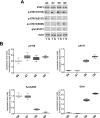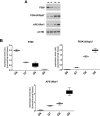Analysis of STAT3 post-translational modifications (PTMs) in human prostate cancer with different Gleason Score
- PMID: 28489571
- PMCID: PMC5522088
- DOI: 10.18632/oncotarget.17245
Analysis of STAT3 post-translational modifications (PTMs) in human prostate cancer with different Gleason Score
Abstract
Prostate Cancer (PCa) is a complex and heterogeneous disease. The androgen receptor (AR) and the signal transducer and activator of transcription 3 (STAT3) could be effective targets for PCa therapy. STAT3, a cytoplasmatic latent transcription factor, is a hub protein for several oncogenic signalling pathways and up-regulates the expression of numerous genes involved in tumor cell proliferation, angiogenesis, metastasis and cell survival. STAT3 activity can be modulated by several Post-Translational Modifications (PTMs) which reflect particular cell conditions and may be implicated in PCa development and progression. The aim of this work was to analyze STAT3 PTMs at different tumor stages and their relationship with STAT3 cellular functions. For this purpose, sixty-five prostatectomy, Formalin-fixed paraffin-embedded (FFPE) specimens, classified with different Gleason Scores, were subjected to immunoblotting, immunofluorescence staining and RT-PCR analysis. All experiments were carried out in matched non-neoplastic and neoplastic tissues. Data obtained showed different STAT3 PTMs profiles among the analyzed tumor grades which correlate with differences in the amount and distribution of specific STAT3 interactors as well as the expression of STAT3 target genes. These results highlight the importance of PTMs as an additional biomarker for the exactly evaluation of the PCa stage and the optimal treatment of this disease.
Keywords: PTMs; STAT3; biomarkers; prostate cancer; signaling pathways.
Conflict of interest statement
The authors have declared that no competing interests exist
Figures




Similar articles
-
STAT3 Post-Translational Modifications Drive Cellular Signaling Pathways in Prostate Cancer Cells.Int J Mol Sci. 2019 Apr 12;20(8):1815. doi: 10.3390/ijms20081815. Int J Mol Sci. 2019. PMID: 31013746 Free PMC article.
-
Cyclin-dependent kinase 5 modulates STAT3 and androgen receptor activation through phosphorylation of Ser⁷²⁷ on STAT3 in prostate cancer cells.Am J Physiol Endocrinol Metab. 2013 Oct 15;305(8):E975-86. doi: 10.1152/ajpendo.00615.2012. Epub 2013 Aug 13. Am J Physiol Endocrinol Metab. 2013. PMID: 23941877
-
MicroRNA alteration and putative target genes in high-grade prostatic intraepithelial neoplasia and prostate cancer: STAT3 and ZEB1 are upregulated during prostate carcinogenesis.Prostate. 2016 Jul;76(10):937-47. doi: 10.1002/pros.23183. Epub 2016 Mar 28. Prostate. 2016. PMID: 27017949
-
Regulating Androgen Receptor Function in Prostate Cancer: Exploring the Diversity of Post-Translational Modifications.Cells. 2024 Jan 19;13(2):191. doi: 10.3390/cells13020191. Cells. 2024. PMID: 38275816 Free PMC article. Review.
-
New approaches to target the androgen receptor and STAT3 for prostate cancer treatments.Mini Rev Med Chem. 2009 Mar;9(3):395-400. doi: 10.2174/1389557510909030395. Mini Rev Med Chem. 2009. PMID: 19275732 Review.
Cited by
-
Expression of tSTAT3, pSTAT3727 , and pSTAT3 705 in the epithelial cells of hormone-naïve prostate cancer.Prostate. 2019 May;79(7):784-797. doi: 10.1002/pros.23787. Epub 2019 Mar 24. Prostate. 2019. PMID: 30905090 Free PMC article.
-
STAT3 and STAT5A are potential therapeutic targets in castration-resistant prostate cancer.Oncotarget. 2017 Sep 12;8(49):85997-86010. doi: 10.18632/oncotarget.20844. eCollection 2017 Oct 17. Oncotarget. 2017. PMID: 29156772 Free PMC article.
-
Shmt2: A Stat3 Signaling New Player in Prostate Cancer Energy Metabolism.Cells. 2019 Sep 6;8(9):1048. doi: 10.3390/cells8091048. Cells. 2019. PMID: 31500219 Free PMC article.
-
STAT3 Post-Translational Modifications Drive Cellular Signaling Pathways in Prostate Cancer Cells.Int J Mol Sci. 2019 Apr 12;20(8):1815. doi: 10.3390/ijms20081815. Int J Mol Sci. 2019. PMID: 31013746 Free PMC article.
-
Galiellalactone inhibits the STAT3/AR signaling axis and suppresses Enzalutamide-resistant Prostate Cancer.Sci Rep. 2018 Nov 23;8(1):17307. doi: 10.1038/s41598-018-35612-z. Sci Rep. 2018. PMID: 30470788 Free PMC article.
References
-
- Tabayoyong W, Abouassaly R. Prostate Cancer Screening and the Associated Controversy. Surg Clin North Am. 2015;95:1023–39. - PubMed
-
- Pinsky PF, Andriole G, Crawford ED, Chia D, Kramer BS, Grubb R, Greenlee R, Gohagan JK. Prostate-specific antigen velocity and prostate cancer gleason grade and stage. Cancer. 2007;109:1689–95. - PubMed
MeSH terms
Substances
LinkOut - more resources
Full Text Sources
Other Literature Sources
Medical
Molecular Biology Databases
Research Materials
Miscellaneous

